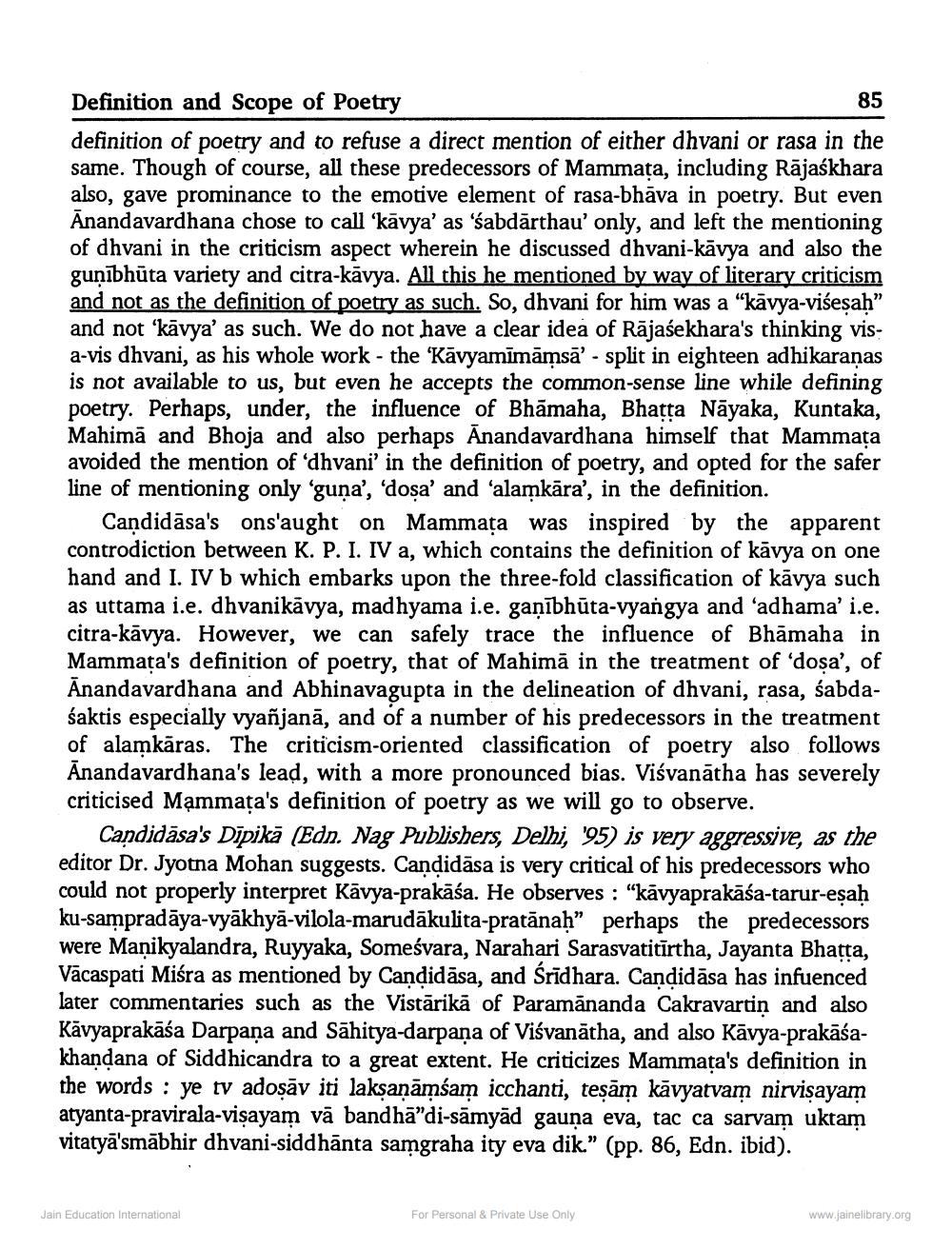________________
Definition and Scope of Poetry
85
definition of poetry and to refuse a direct mention of either dhvani or rasa in the same. Though of course, all these predecessors of Mammaţa, including Rājaśkhara also, gave prominance to the emotive element of rasa-bhāva in poetry. But even Anandavardhana chose to call 'kavya' as 'śabdārthau' only, and left the mentioning of dhvani in the criticism aspect wherein he discussed dhvani-kavya and also the gunībhūta variety and citra-kāvya. All this he mentioned by way of literary criticism and not as the definition of poetry as such. So, dhvani for him was a "kāvya-viśesah” and not 'kavya' as such. We do not have a clear idea of Rājasekhara's thinking visa-vis dhvani, as his whole work - the 'Kavyamīmāmsā' - split in eighteen adhikaranas is not available to us, but even he accepts the common sense line while defining poetry. Perhaps, under, the influence of Bhāmaha, Bhatta Nāyaka, Kuntaka, Mahim, and Bhoja and also perhaps Anandavardhana himself that Mammata avoided the mention of 'dhvani' in the definition of poetry, and opted for the safer line of mentioning only 'guna', 'dosa' and 'alamkāra', in the definition.
Candidāsa's ons'aught on Mammata was inspired by the apparent controdiction between K. P. I. IV a, which contains the definition of kāvya on one hand and I. IV b which embarks upon the three-fold classification of kāvya such as uttama i.e. dhvanikavya, madhyama i.e. ganībhūta-vyangya and 'adhama' i.e. citra-kāvya. However, we can safely trace the influence of Bhāmaha in Mammata's definition of poetry, that of Mahimā in the treatment of 'dosa', of Anandavardhana and Abhinavagupta in the delineation of dhvani, rasa, sabdaśaktis especially vyañjanā, and of a number of his predecessors in the treatment of alamkāras. The criticism-oriented classification of poetry also follows Anandavardhana's lead, with a more pronounced bias. Visvanātha has severely criticised Mammața's definition of poetry as we will go to observe.
Candidāsa's Dīpikā (Edn. Nag Publishers, Delhi, '95) is very aggressive, as the editor Dr. Jyotna Mohan suggests. Candidāsa is very critical of his predecessors who could not properly interpret Kāvya-prakāśa. He observes : “kāvyaprakāśa-tarur-esaḥ ku-sampradāya-vyakhya-vilola-marudākulita-pratānah" perhaps the predecessors were Manikyalandra, Ruyyaka, Someśvara, Narahari Sarasvatitirtha, Jayanta Bhatta, Vācaspati Miśra as mentioned by Candidāsa, and Śrīdhara. Candidāsa has infuenced later commentaries such as the Vistārikā of Paramānanda Cakravartin and also Kāvyaprakāśa Darpana and Sāhitya-darpana of Viśvanātha, and also Kāvya-prakāśakhandana of Siddhicandra to a great extent. He criticizes Mammata's definition in the words : ye tv adoṣāv iti laksanāmśam icchanti, teşām kāvyatvam nirvisayam atyanta-pravirala-visayam vā bandhā"di-sāmyad gauna eva, tac ca sarvam uktam vitatyā'smābhir dhvani-siddhānta samgraha ity eva dik." (pp. 86, Edn. ibid).
Jain Education International
For Personal & Private Use Only
www.jainelibrary.org




